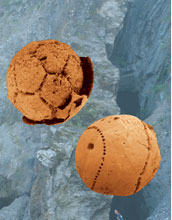Multimedia Gallery
Scanning electron photomicrographs of two fossil embryo specimens
Scanning electron photomicrographs of two fossil embryo specimens from the 600 million-year-old Doushantuo Formation in South China. The soccer ball-shaped specimen is interpreted as an early stage (blastula) embryo and the baseball-shaped specimen is interpreted as an intermediate-stage helical embryo consisting of three clockwise coils. Each embryo used to be enclosed in an envelope, that was removed (a piece still remains in the soccer ball-shaped specimen) so that the embryo itself was exposed. The embryos are about 0.55 to 0.75 millimeters in diameter. The background shows the Doushantuo rocks from which the embryos were extracted. (Date of image: 2007)
More About This Image
Research by Shuhai Xiao, a professor of geobiology at Virginia Tech, has found evidence that animals may have existed before the Cambrian period (542 to 488 million years ago) in the Precambrian period, which spans from 4.5 billion years ago to the beginning of the Cambrian period.
In 1997, Xiao and colleagues discovered in the Doushantuo Formation, thousands of 600 million-year-old embryo microfossils. Then in 2000, Xiao's team reported the discovery of a tubular, coral-like animal in a later stage of development than embryonic.
Xiao and colleagues are trying to learn more about these animals that are between the embryonic and adult stages. Only 80 have been recovered that are in an advanced to intermediary stage of development; the rest have been early stage embryos. These intermediate stage embroyos have a coiled, tubular embryo imbedded in their egg case. The egg cases have a groove on the surface that consists of three clockwise coils. The researchers used microfocus X-ray computed tomography imaging to virtually peel off the egg case and expose the embryo inside. The tubular embryo is also coiled, with three clockwise coils; some specimens showed signs of uncoiling.
"We think it's safe to say these are juvenile or adult stage organisms," Xiao says. "Uncoiling indicates these embryos would have grown into the tubular organisms that we discovered earlier in our research."
The researchers believe the embroyos were animals similar to corals. Although these creatures were soft-bodied (without skeletons), they were well preserved in rocks that predate the Cambrian period. Xiao says this supports the existence of animals in the Precambrian period. "We didn't see the animal fossil, but we saw the trace of the animal," says Xiao, who along with colleagues estimates this animal to be at least 550 million years old (or about 9 million years before the Cambrian period).
Xiao and colleagues are also studying the connection between the rate of evolution, which accelerated in the Cambrian period, and oxygen. Xiao says that one of the reasons the number of animals species exploded during the early Cambrian may have been oxygen. "Suddenly there was more oxygen," says Xiao, "and we know that almost all animals need oxygen to survive."
Evidence of several oxidation events during the time period suggests a connection between oxidation and evolution. Kathleen McFadden, who was a Ph.D. student with Xiao at the time, studied the ratio of carbon and sulfur in the million-year-old rocks at the Yangtze Gorges of South China and determined from the carbon/sulfur cycles, that several significant oxidation events occurred as life was forming.
McFadden and colleagues meticulously analyzed layers of rock at the site of an ancient sea in the Yangtze Gorges. The layers of sediment represent millions of years of deposits. McFadden went through road cuts, bed by bed, measuring and describing the exposed rock and taking small rock samples every few feet. She collected about 200 samples. While the triggers for the oxidation events are still not clear, "these events recorded in the ocean were probably related to oxygen in the atmosphere reacting with sediments on land," McFadden says. Xiao notes that after each oxidation event, there is more diversification of species.
Future research for Xiao includes exploring how these Precambrian animals were preserved and determining if animals in the Cambrian period are descended from the Precambrian animals or can be linked to that period.
This research was a collaborative project involving researchers from Virginia Tech, the University of Maryland, the University of Nevada at Las Vegas and the Chinese Academy of Sciences. The participation of the American universities was funded by the National Science Foundation.
This text was taken from the story "Scientist Searches for Clues About the Beginnings of Life" that appeared in Virginia Tech's Research magazine, Winter 2010.
Credit: Shuhai Xiao
Images and other media in the National Science Foundation Multimedia Gallery are available for use in print and electronic material by NSF employees, members of the media, university staff, teachers and the general public. All media in the gallery are intended for personal, educational and nonprofit/non-commercial use only.
Images credited to the National Science Foundation, a federal agency, are in the public domain. The images were created by employees of the United States Government as part of their official duties or prepared by contractors as "works for hire" for NSF. You may freely use NSF-credited images and, at your discretion, credit NSF with a "Courtesy: National Science Foundation" notation.
Additional information about general usage can be found in Conditions.
Also Available:
Download the high-resolution JPG version of the image. (5.5 MB)
Use your mouse to right-click (Mac users may need to Ctrl-click) the link above and choose the option that will save the file or target to your computer.

 All images in this series
All images in this series